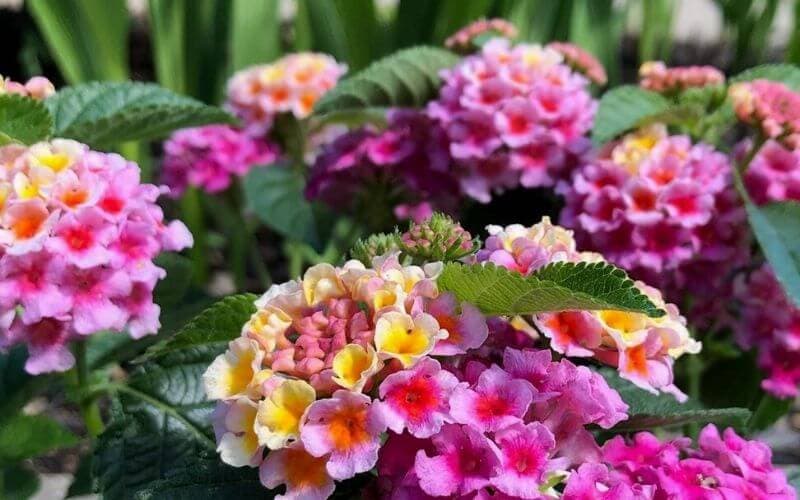
Deciding what type of flowers should go in your garden is no easy task! Should you go with a lilies or a lantana? Do you live in a location that can support lantanas? Will a lantana fit in your garden, both aesthetically and physically?
Lantana flowers are known for their beauty, ability to bloom year-round in areas without frost, and their multitude of sizes. Lantanas can be grown in many zones and are all-around low maintenance.
And if you want lantanas in your garden, then the next step is to decide from one of the 150 species of lantana plants.
To help guide you through the process of choosing which lantanas will grow best in your garden, I created this list of the 10 best lantanas.
You will learn about each lantanas height, growing zones, blooming seasons, sunlight needs, and much more. At the bottom there is a chart with all of this info for quick comparison.
Top 10 Eye-Catching Lantana Varieties To Plamt
So get this, each lantana can range anywhere from 10 inches to 6 feet in height. They come in any color you can think of. These plants are native to the Americas and Africa but have been introduced to Australia and India. And this is just the beginning…
Read on to learn more interesting facts about the 10 good lantana varieties to consider for your garden.
Types of Lantana | Height | Growing Zones | Blooming Season | Light |
Lantana Silver Mound | 18”-24” | 8a-10b | Year-Round, or Until Frost | Full Sun |
Lantana Radiation | 4’-6’ | 8-10, 12-24 | Year-Round, or Until Frost | Full Sun |
Lantana Lucky White | 12”-16” | 8-10, 12-24 | Summer | Full Sun |
Lantana Lucky Lavender | 12”-16” | 9-11 | Summer | Full Sun |
Lantana Little Lucky Red | 10”-12” | 8a-10b | Year-Round, or Until Frost | Full Sun |
Lantana Little Lucky Peach Glow | 10”-12” | 8-10, 12-24 | Year-Round, or Until Frost | Full Sun |
LantanaCamara Landmark Peach Sunrise | 15”-20” | 8-10, 12-24 | Year-Round, or Until Frost | Full Sun, Part Sun, Part Shade |
LantanaCamara Landmark Citrus | 15”-20” | 8-10, 12-24 | Year-Round, or Until Frost | Full Sun |
Lantana Bandana Red | 18”-24” | 9a, 9b, 10a, 10b, 11a, 11b | Year-Round, or Until Frost | Full Sun, Part Sun, Part Shade |
Lantana Athens Rose | 36”-48” | 8a-11 | Summer | Full Sun or Part Sun |
1. Lantana Little Lucky Peach Glow
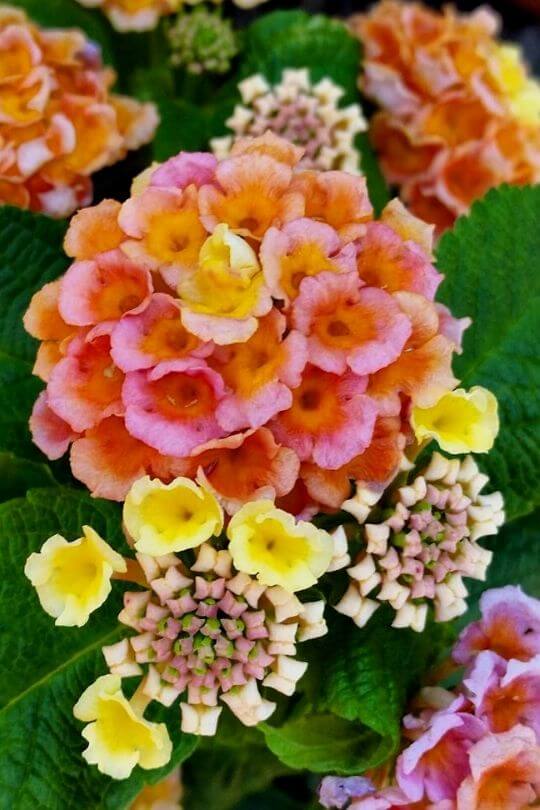
This little sun-loving evergreen shrub blooms from late spring to fall if you live in an area that can become frosty. Otherwise, it is year-round! It can easily be grown in average, medium moisture and well-drained soils.
With tolerance to salt, this flower is perfect for your garden if you live near the beach. Also, these plants are great for being placed in small gardens and containers.
One of the best parts about this plant is how low maintenance it is. Not only does it need a little amount of water, but it is tolerant of deer, rabbits, and most other animals.
If you go with this plant, you won’t have to worry about the upkeep of it! In fact, the only maintenance that you have to deal with is to prune it after its first flowering. This will help the plant to grow additional flower buds. But even this is optional!
This plant thrives from full exposure from the sun.
These typically have bushy green foliage that is covered with beautiful flowers. These flowers can be a lovely combination of gold, salmon-pink, and of course peach.
The blooming of this flower attracts butterflies and hummingbirds with its warm collection of colors.
Be careful though! Like most other lantanas, this plant is highly toxic if it is ingested.
2. Lantana Radiation
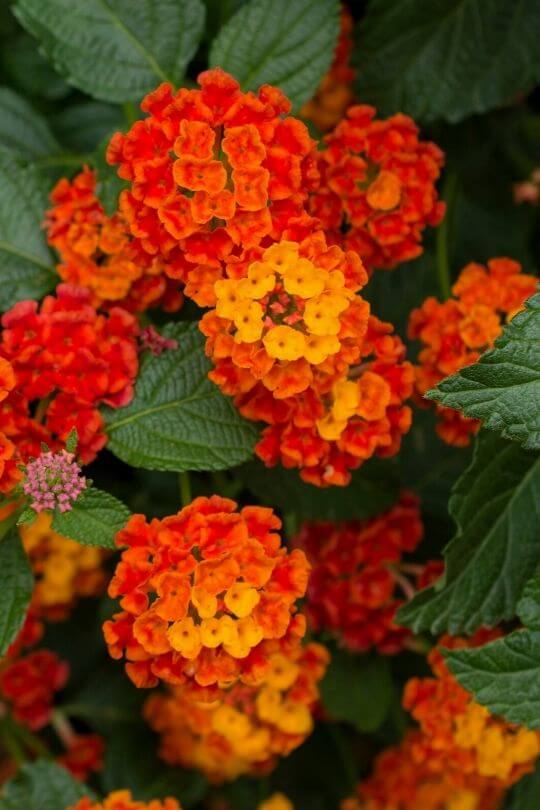
This amazing shrub has flower buds that bloom with a combination of red and orange.
The Lantana Radiation is a low maintenance flower. They only need water occasionally, but in hot temps, they need water more frequently.
This plant thrives in the extreme heat of summer and while many other flowers stop blooming. In frost-free regions, this plant will bloom year-round. But in areas with frost, it will bloom spring through summer.
The Lantana Radiation needs full sun to grow properly.
The best soil for this plant is well-drained soil. After you have planted it, make sure to water it deeply so it can establish its roots in the first growing season. However, if you choose to put it in a container, continue to water it deeply even after the first growing season.
This shrub has a moderate growth rate and a mounding growth habit.
It’s growing zone is in 8-10, 12-24. And with a moderate growth rate, it will become full-sized around 4’-6’.
3. Lantana Camara Landmark Citrus
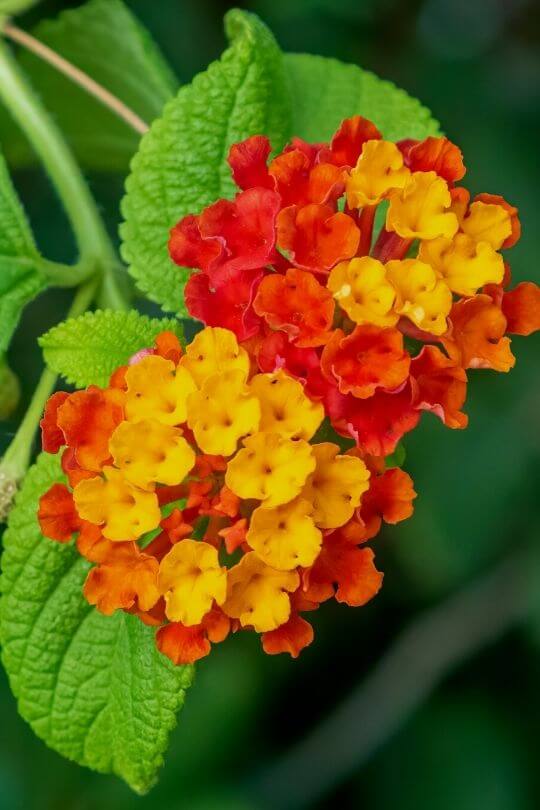
With vivant flowers that are colored tangerine and lemon, this Lantana shrub variety is gorgeous in every way.
When you are planting the Lantana Camara Landmark Citrus, make sure it is in full sun. This will allow it to grow to its full potential. And of course, bloom with gorgeous flowers!
This is a low maintenance plant with tolerance to salt. This would be a great plant for someone who lives near the beach.
Deer and rabbits are no match for this plant. This plant will attract butterflies and hummingbirds alike. Look at those beautiful tangerine and lemon colors, how could our friendly pollinators not be attracted to those flowers!
Whether you want to plant this in a container or open garden it doesn’t matter. This plant will thrive in any size space that is available.
This will even thrive on slopes and banks. Making it a great candidate to be planted on your hillside.
The soil you use to plant this shrub needs to be moist but well-drained. Otherwise, it will be at risk for root mold or drought.
4. Lantana Bandana Red
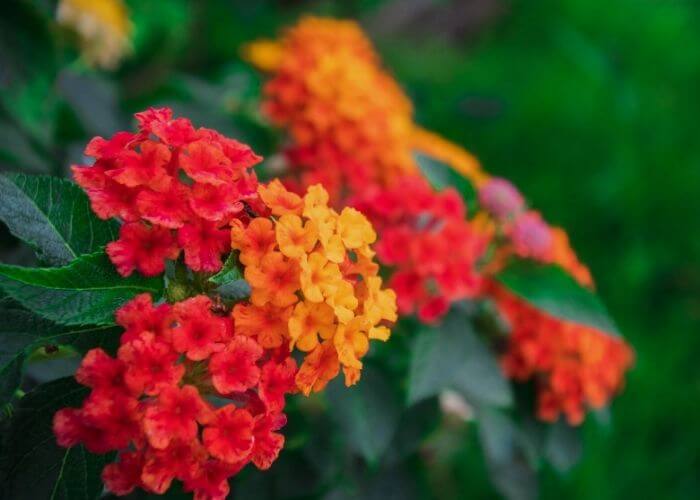
The Lantana Bandana Red flowers bloom into a dark yellow, then a deep orange, and finally they become a deep red.
This plant variety can also be put into a container or your open garden. If it is in your container, it will need to be watered more frequently.
This plant has a heavy display of nectar-rich flowers during spring until it is frosty out. However, if you live in a warmer climate the flowers will bloom year-round.
This gives it the ability to attract butterflies and hummingbirds. A wonderful addition to the garden!
To treat this plant the way it deserves, make sure your soil is average moist, and well-drained.
Also, this lantana has the ability to thrive in full sun, part sun, or part shade. Giving it more options of where it can be planted in your garden.
Not only that, but this plant is heat tolerant, deer resistant, and all-around easy to take care of.
A great choice for beginner gardeners because of the easy maintenance and planting location! But without a doubt still an excellent choice for gardeners with experience.
5. Lantana Camara Landmark Peach Sunrise

A Lantana Camara Landmark Peach Sunrise is known for its ability to bloom with a shade of yellow, and progress into a salmon-peach. These warm colors are perfect for any garden!
They are resistant to deer and rabbits. They have the ability to thrive in all soil types. But if you want to have this lantana grow to its maximum potential, you will need soil that is slightly acidic and well-drained.
These are great for containers and open gardens. If you choose to plant them in a container, make sure to water them more.
All around a pretty low maintenance plant that is great for those of you who don’t have a ton of time to spend working in your garden.
As always, plant this in the spring, and prune back the foliage after the first blooming to encourage extra flower bud growth.
6. Lantana Silver Mound
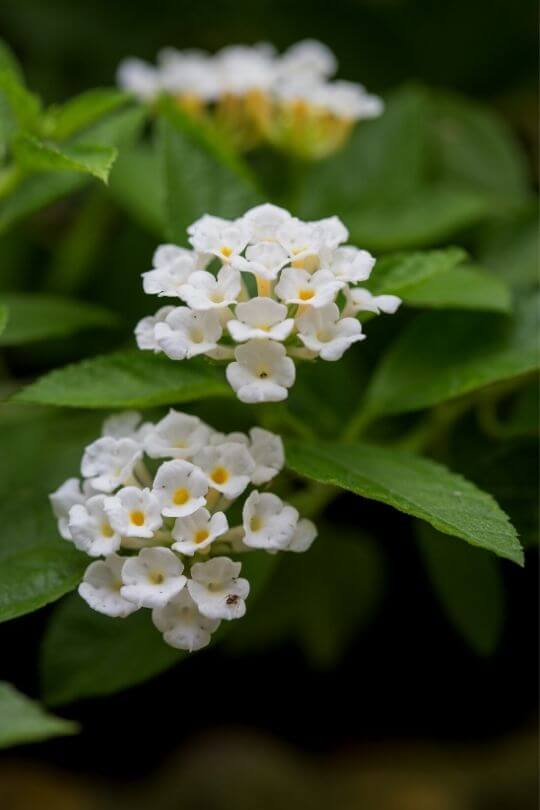
The Lantana Silver Mound will bloom with magnificent soft yellow, that will mature to white. You can expect this flower to be blooming from spring to fall if you live in a frosty environment. Otherwise, enjoy the flowers of this lantana year-round!
These are low maintenance flowers with the ability to thrive in most environments. This comes from their tolerance to most things.
Excessive heat and long droughts will not cause long term damage to these guys. Deer, rabbits, and other animals are not interested in this flower because it is toxic to them.
On the flip side, they attract butterflies and hummingbirds with their beautiful flowers.
This plant will do great in containers and open gardens. Making it easier to plant near other flowers that will create a beautiful color scheme.
All in all, it is a great plant for any garden!
7. Lantana Little Lucky Red

The Lantana Little Lucky Red blooms with a gorgeous combination of gold, orange, and red. Making it an amazing flower in your garden.
So here’s the thing…
These flowers can be easily grown in all types of soil. Including average, medium, and well-drained soils. Heck, even some poor soil will be enough for this plant to grow!
This too is great for open gardens or containers. It is especially ideal for smaller gardens due to the small size of the plant.
All around a pretty low-maintenance plant.
With a blooming period that starts 3 entire weeks before most other lantanas.
It only releases a little amount of seeds. And with a little number of seeds, it produces fewer berries than other lantanas. This means that these flowers will spend all of their energy creating flowers.
This plant is highly toxic if ingested! So the little number of berries produced is a benefit if your pets are known to eat plants.
This lantana is definitely a great plant for beginner gardeners because of its many tolerances. But it is also great for the most experienced gardeners as well!
8. Lantana Athens Rose
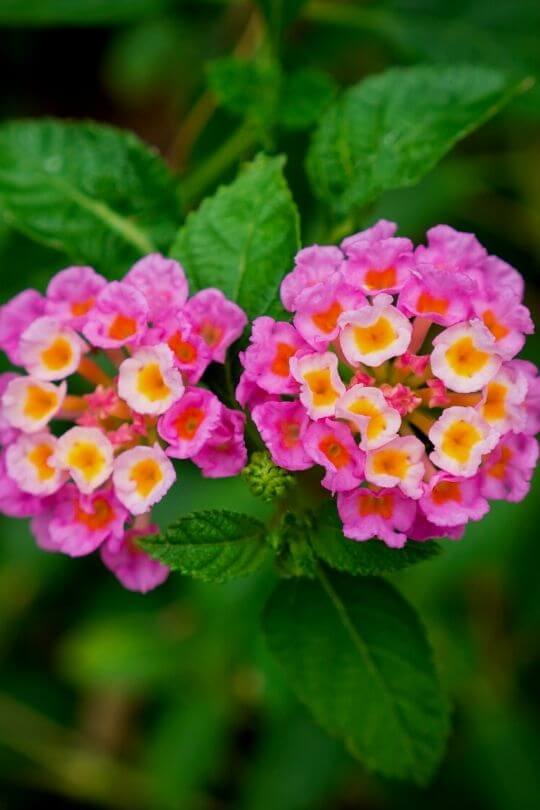
A Lantana Athens Rose blooms into an amazing blend of pink, rose, magenta, and yellow.
These magnificent colors attract butterflies and hummingbirds.
Like most other lantanas, this plant is also poisonous if ingested. But this makes them resistant to deer and other unwanted animals. This plant would be perfect if you live near the ocean because it is tolerant of salt.
This can be planted in an open garden, or a container as long as it is larger than 3 gallons.
It only needs to be watered occasionally and can endure droughts, although it is best not to neglect your plants.
This plant has a smaller blooming window than other lantanas. But the summer is still long enough to enjoy its amazing flowers in your garden!
9. Lantana Lucky Lavender
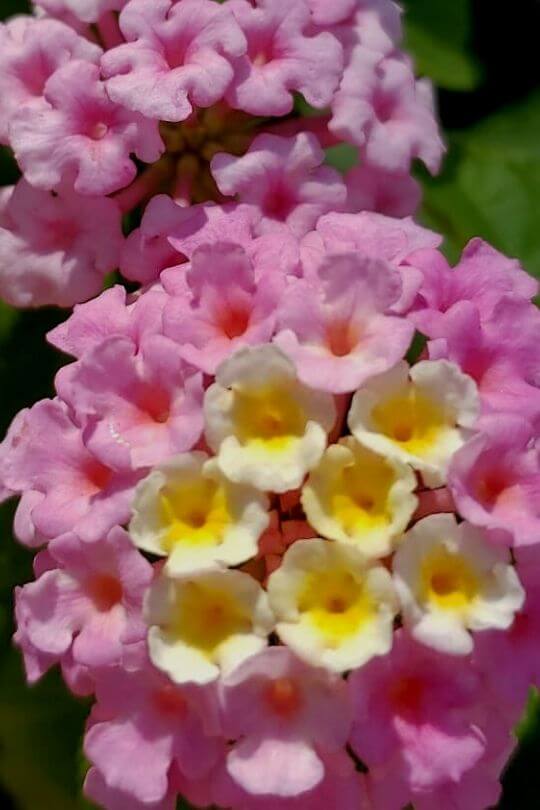
The Lantana Lucky Lavender blooms colorfully with lavender and a butter-like yellow. This creates an awesome contrast between the foliage and the flowers that really make it stand out.
A common trait between all lucky lantanas is that they are compact plants with a very heavy bloom. This means that they will thrive in both a container and an open garden setting.
This is definitely a low maintenance plant with the ability to grow in all sorts of different qualities of soil. The plant is very tolerant in the sense that it can survive the poor conditions of heat, humidity, and salt.
With a small number of seeds, this plant produces a little amount of berries. What this allows the plant to do is spend more of its energy on creating flowers.
The Lantana Lucky Lavender is a great plant for beginner gardeners. but still an excellent choice for all of you gardeners with plenty of experience.
10. Lantana Lucky White
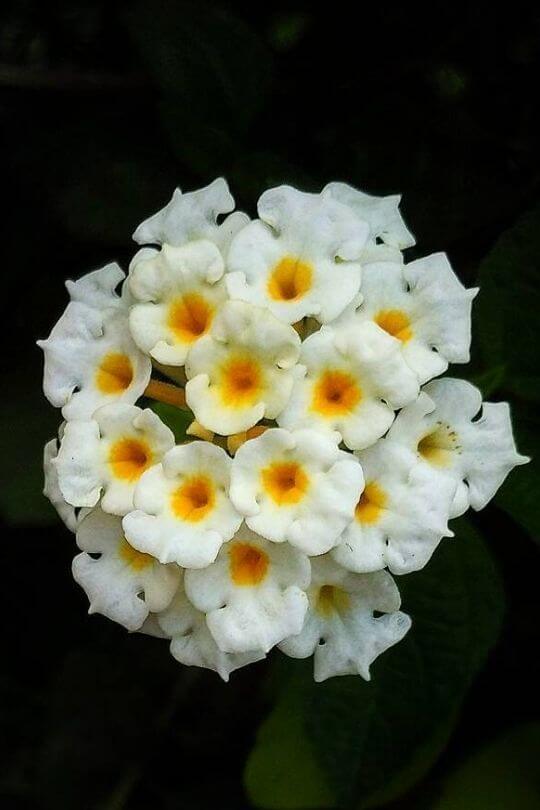
This magnificent flower blooms with a vibrant shade of white, and a hint of buttery yellow. This color scheme and scent is so magnificent, that butterflies and hummingbirds just have to come to the flowers!
The Lantana Lucky White thrives in the heat and will do well in poor soil quality. Not only that…
It is low maintenance and great for someone who wants to have less longterm gardening responsibilities. Without sacrificing the beauty of this flower!
The dark green foliage creates a beautiful contrast with the bright color of the flowers.
So get this, it also has a glorious scent that can create a lively feel in your garden!
This flower is resistant to deer and other harmful insects. Making it even more low maintenance of a plant to own.
If you live by the ocean, this plant is a great choice for you. It is tolerant to the salt and loves humidity.
The Lantana Lucky White can grow in an open garden or in containers.
This lantana is a great choice for beginners, but still an excellent choice for experienced gardeners.
Fun fact: If you have ever confused a lantana for a verbena, you are not alone! These two plants are from the same family of Verbenaceae and look very much the same. Although it is important to distinguish which type of flower you have.
This is because lantanas and verbenas have different levels of care requirements.
Which One Of These Flowers Should You Plant In Your Garden?
With all of these beautiful options, it can be difficult to figure out which flowers are right for your garden! The options are endless.
So to make it even easier for you to decide, I made this quick guide.
Guidelines For Choosing Your Flowers:
This will help you figure out which flowers are candidates to grow in your garden. And once you know that, the fun of physically creating your garden begins!
What Other Plants Should You Have With Your Lantanas?
Now that you know what lantanas are best to plant in your garden, its time for something else…
Plants that pair great with lantanas! Even though lantanas make a great stand-alone plant, the color scheme of your garden can be spiced up with some variety.
The best kind of plants to pair with your lantanas is more sun-loving plants.
Look for sun-loving varieties of:
These will thrive in similar areas as your lantanas because of their desire for sun. They are just different enough to create that magnificent color scheme and feel you are looking for!
But if you are a die-hard lantana enthusiast, don’t bother planting anything else! There are so many varieties of lantanas that you can easily create the color scheme you want in your garden.
Conclusion
I sure hope that you learned something from this post and go out and add the perfect lantana to your own garden! No matter what color scheme you want your garden to be like, you will find the color of lantanas that you want.
Not only are they easy to grow and maintain, but they are shockingly gorgeous. With their tolerance to salt, deer, and many other things, you really can’t go wrong with any variety of lantanas. Just make sure that they can be grown in your area.
Which lantana do you want to try planting first? Will you try the Lantana Silver Mound? Or how about the Lantana Little Lucky Red?

Written By
John Haryasz
John Haryasz is a writer with a background in landscape architecture. His education includes a Bachelor of Science in landscape architecture from UMass, Amherst with a minor in psychology. Following graduation, John worked in a small landscape architecture office. In this role, he led many successful projects in Berkshire County, MA. After a few years, John began offering freelance design services. He has since produced designs for projects across the country. As a writer, John aims to share knowledge while promoting engagement with the outdoor world.

I have had 2 large orange lantana bushes planted near our pool for years. The bushes are very healthy looking but this is the first year they have not bloomed. I’m in central Ga. zone 8. Any idea fir this issue?
To encourage blooming, continually deadhead lantana plants by removing faded blooms, seeds or berries throughout the blooming season from late spring until frost. In addition to deadheading, shear off the new growth on branch tips to boost repeat blooming.
I am a certified arborist, have been in horticulture , and agriculture for all my life.
Lantanas have mesmorized me for many years. Such unique blooming plants. I am 76 years old, so I have seen a few in my day. I recommend them to all stages of plant growing. Woderful in any yard. Needs sunlight. Go for it, time is a waiting game. We are very close to the 23 growing season. Ron Kasting
How much sunlight are we talking about? I’m looking for some for coverage of my ground area, no bushes but I want perennials. Any suggestions? Would love red or a mixture of reds, oranges, etc.